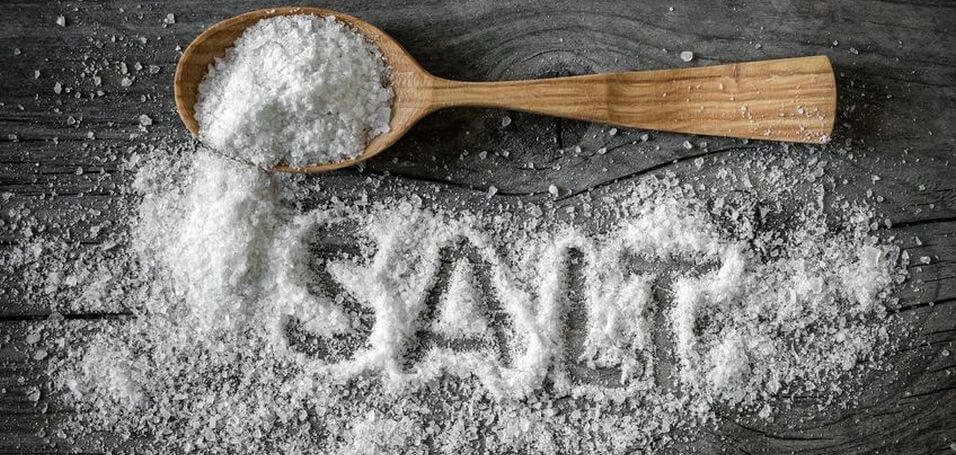Salt has been demonized for decades now.
Eat too much of it, we’ve been told by doctors, government agencies, and self-styled gurus, and we’re courting disasters like heart disease, stroke, and diabetes.
Some people even say salt overconsumption can make us fatter.
And so you’ve cut back on salting your meals, and understandably so. Even if you’re skeptical, it’s better to be safe than sorry, right?
Well, as you’re about to learn in this article, the case against salt isn’t as open-and-shut as you’ve been led to believe. In fact, it’s more of a bum rap than anything else.
Salt isn’t inherently dangerous, and while it’s also not wholly harmless, if you eat a nutritious diet, exercise regularly, and maintain a healthy body weight, you probably don’t need to worry about how much you’re eating.
Let’s find out why…
- Why All the Fuss Over How Much Salt We’re Eating?
- Why Salt Isn’t As Bad As You’re Being Told
- How Much Salt Is Too Much?
- How to Eat Less Sodium
- The Bottom Line on How Much Salt to Eat
Table of Contents
Want to listen to more stuff like this? Check out my podcast!
Why All the Fuss Over How Much Salt We’re Eating?
Our modern obsession with salt intake began in the early 1900s, when French doctors noticed that some of their patients with high blood pressure also ate high-salt diets.
Then, a few decades later, scientists discovered that they could induce high blood pressure in mice by feeding them a high-sodium diet.
(Sodium, by the way, is a naturally occurring mineral in salt.)
They also noted that countries that tended to eat more salt, like Japan, also had higher rates of high blood pressure and strokes.
This sparked a flurry of epidemiological research that affirmed correlations between high sodium intake and high blood pressure and obesity, and the “salt is killing you” headlines were soon to follow.
Mainstream hysteria took hold, and the connection between salt and disease was unofficially canonized. Before long, “everybody knew” that you had to eat as little salt as possible if you wanted a healthy heart and circulatory system.
What was missed, though, is correlation doesn’t mean causation.
In other words, just because people that eat high-salt diets also tend to experience various types of health problems doesn’t mean that the salt is the culprit.
It could be something else altogether that they tend to share in common, like obesity, inactivity, smoking, and so forth, which brings me to the next act in the story…


Why Salt Isn’t As Bad As You’re Being Told
The counterargument to the prevailing bias against salt and sodium started to take shape in 2003, when an extensive review of the sodium literature concluded that “there is little evidence for long-term benefit from reducing salt intake.”
This was echoed eight years later, in a meta-analysis of seven studies including more than 6,250 subjects, where scientists found no evidence supporting cutting salt as a way to reduce the risk for heart attack, stroke, or death in those with either normal or high blood pressure.
Further research published in 2015 found that a lower consumption of sodium may actually be associated with a higher risk of dying from heart disease.
Why the volte-face, you’re wondering?
Well, while researchers did find that people who eat the most salt also tend to have a higher risk of various types of disease, it turns out that salt wasn’t at the root of their problems.
First, most of the salt they ate came from junk food, which contains trans fats (which are highly detrimental to your health), processed sugar, and more calories than most unprocessed foods.
They also tended to be fatter, less active, and more likely to overeat, which are all associated with poorer health.
We also now know that genetics and cultural factors influence how salt affects our bodies. Some people are naturally more sensitive to it than others.
Yet another important factor is your potassium intake.
Studies show that the ratio of our sodium to potassium intake may be more important than our total intake of either nutrient.
One of the largest of these studies was conducted by scientists at the Center for Disease Control and Harvard University, and it found that people with the highest ratio of sodium to potassium were twice as likely to die of a heart attack, and had a 50% higher risk of overall death than people with the lowest ratio.
In other words, eating a lot of salt and a little potassium is bad for your body.
That’s why The Institute of Medicine recommends that we ingest just 2.3 grams of sodium (about one teaspoon of salt) and 4.7 grams of potassium every day.
Unfortunately, most of us have that backward, eating, on average, ~3.4 grams of sodium and just 2.64 grams of potassium per day, making inadequate potassium intake one of the most common nutrient deficiencies in the U.S.
Why do we have this so ass backward, you’re wondering?
Well, here’s a short list of some of the most sodium-rich foods you can eat:
- Yeast breads
- Canned and pre-packaged foods
- Anything with a lot of cheese, like pizza
- Sauces of any kind
- Processed meats like cold cuts, hot dogs, bacon, and sausage
You know, the type of stuff that many people eat regularly.
Furthermore, the best sources of potassium are, unsurprisingly, also the types of foods that most people avoid: fruits and vegetables.
Yet another reason to eat a nutritious diet…
How Much Salt Is Too Much?

Salt may not be as bad as we once thought, but that doesn’t mean we should eat as much as we want.
I think a good starting place is the IoM’s recommendation of 2.3 grams of sodium, or one teaspoon of salt, per day.
(Note: That number drops down to 1.5 grams per day for African Americans, and people with hypertension, diabetes, or chronic kidney disease, and people aged 51 and older.
If you sweat regularly, you’ll want to increase your sodium intake to offset what you lose through sweating.
Personally, I eat 3 to 4 grams of sodium per day, and I exercise vigorously for 4 to 6 hours per week.
So, if you’re ready to get your sodium intake under control…
- Open a spreadsheet.
- Head over to Calorie King.
- Add up the sodium content of the foods you typically eat. (Don’t forget the salt that you add to meals!)
- Determine if you need to eat more or less.
Oh and if the thought of having to plan and track yet another part of your diet seems burdensome, don’t worry.
You don’t have to track your sodium and potassium intake forever.
Instead, track them for as long as it takes to see what works and what doesn’t, and then just use common sense in maintaining good habits going forward.
How to Eat Less Sodium

If you’ve calculated your sodium intake and it’s far too high, then you need to adjust it downward.
Here are seven tips for doing just that.
1. Cut back on salt and certain seasonings.
Most of the sodium in our diets comes from salt, which is about 40% sodium and 60% chloride.
Thus, the easiest way to reduce your sodium intake is to reduce the salt in your diet.
Do this by using salt sparingly, or by combining it with a potassium-based salt substitute like NoSalt and LoSalt. (These are also good for increasing your potassium intake.)
Check the labels on mixed seasonings as well, like chili, curry, and pizza seasoning. They can contain quite a bit of sodium.
2. Look at the sodium content of canned or pre-packaged foods.
They’re often packed with sodium as a preservative.
3. Avoid deli (and other cured) meats.
For the same reason.
4. Understand food labels.
- “Sodium-free” means less than 5 milligrams of sodium per serving with no added salt.
- “Very low sodium” means 35 milligrams of sodium or less per serving.
- “Low sodium” means 140 milligrams of sodium or less per serving.
- “Reduced (or less) sodium” means at least 25% less sodium per serving than the regular food.
- “Light in sodium” means sodium has been reduced by at least 50% per serving.
5. Check sauces and salad dressings.
Many are high in sodium, and some are very high, like Worcestershire and soy sauce, and Italian salad dressing.
6. Limit your cheese intake.
Just one ounce of American cheese has nearly 500 milligrams of sodium, and other types contain even more.
7. Include more potassium-rich foods in your diet/meal plans.
My favorite choices are…
- Beans (2 to 3 grams of potassium per cup)
- Yogurt (250 to 400 milligrams of potassium per cup)
- Dark leafy greens (500 to 1,500 milligrams of potassium per cup)
- Avocado (~1 gram of potassium per fruit)
- Mushrooms (300 to 400 milligrams of potassium per cup)
- Banana (400 to 500 milligrams of potassium for a medium-sized)
- Squash (100 to 500 milligrams of potassium for medium-sized)
- Potato (~900 milligrams of potassium for medium-sized)
- Salmon (~100 milligrams of potassium per ounce)
The Bottom Line on How Much Salt to Eat
If you’re like most people, your diet is probably too high in sodium and too low in potassium.
That doesn’t necessarily mean you’re eating too much salt, though. It just means that your diet needs some adjusting.
If, however, you eat plenty of nutritious foods, including fruits and vegetables, and exercise regularly, and aren’t overweight, then you probably don’t need to worry about your salt intake.
You also shouldn’t buy into the sodium hysteria, and try to minimize your intake of it.
Ironically, research shows that a low-sodium diet can increase the risk of various types of disease and dysfunction, including…
So, as people often say in the health and fitness space, it’s all about balance.









